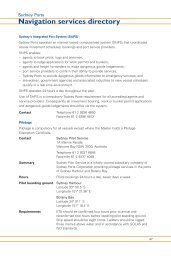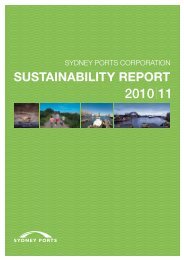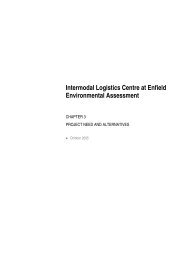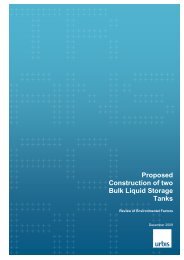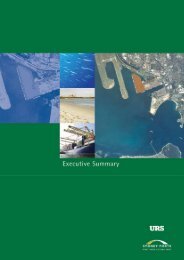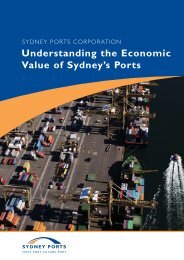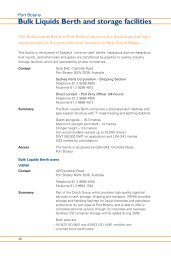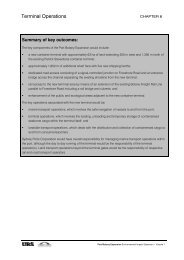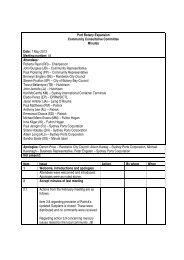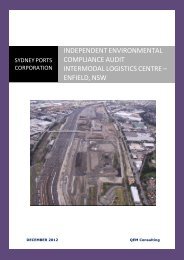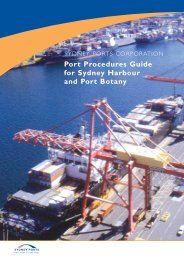SYDNEY PORTS CORPORATION ANNUAL REPORT 12
SYDNEY PORTS CORPORATION ANNUAL REPORT 12
SYDNEY PORTS CORPORATION ANNUAL REPORT 12
You also want an ePaper? Increase the reach of your titles
YUMPU automatically turns print PDFs into web optimized ePapers that Google loves.
(u) Contributed equity<br />
Ordinary shares are classified as equity.<br />
The State Owned Corporations Act 1989 requires the<br />
Corporation to have two voting shareholding Ministers.<br />
Each shareholder must, at all times, have an equal number<br />
of shares in the Corporation. At 30 June 20<strong>12</strong>, the shares<br />
were held by the Treasurer (The Hon. M. Baird, MP) and<br />
the Minister for Finance and Services, Minister for the<br />
Illawarra (The Hon. G. Pearce, MLC).<br />
(v) Revenue recognition<br />
Revenue is recognised and measured at the fair value of<br />
the consideration or contribution received or receivable to<br />
the extent it is probable that the economic benefits will flow<br />
to the Corporation and the revenue can be reliably measured.<br />
The following specific recognition criteria must also be met<br />
before revenue is recognised:<br />
(i) Port revenue<br />
Port revenue from pilotage and navigation services,<br />
wharfage, site occupation charges, mooring fees and other<br />
services are recognised on delivery of the service to the<br />
customer.<br />
(ii) Rental revenue<br />
Rental revenue is accounted for on a straight-line basis<br />
over the lease term.<br />
(iii) Interest revenue<br />
Interest revenue is recognised on an accrual basis using<br />
the effective interest method.<br />
(iv) Retirement benefits income<br />
Retirement benefits income relates to the net of current<br />
service costs, interest costs and expected return on Fund<br />
assets for the defined benefits superannuation schemes.<br />
Schemes in net expense position are recognised in<br />
employee benefit expense.<br />
(v) Sale of assets<br />
Revenue from the sale of assets is recognised as revenue<br />
when the Corporation transfers the significant risks and<br />
rewards of ownership of the assets.<br />
(vi) Assets received free of charge<br />
Assets received at no cost are recognised as revenue at<br />
the fair value of the asset on the date of receipt.<br />
(w) Income tax equivalent and other taxes<br />
Income tax equivalent is required to be paid to the NSW<br />
Government in accordance with Section 20T of the State<br />
Owned Corporations Act 1989. The payments are equivalent<br />
to the amounts that would be payable under the normal<br />
income tax law of the Commonwealth. The National Tax<br />
Equivalent Regime was established on 1 July 2001, with the<br />
Australian Taxation Office administering the tax equivalent<br />
scheme across Australia.<br />
Current tax assets and liabilities for the current and prior<br />
periods are measured at the amount expected to be<br />
recovered from or paid to the taxation authorities based on<br />
the relevant period’s taxable income. The tax rates and the<br />
tax laws used to compute the amount are those that are<br />
enacted or substantively enacted by the statement of<br />
financial position date.<br />
Deferred income tax is provided on all temporary<br />
differences at the statement of financial position date<br />
between the tax bases of assets and liabilities and their<br />
carrying amounts for financial reporting purposes.<br />
Deferred income tax liabilities are recognised for all taxable<br />
temporary differences:<br />
■■ Except where the deferred income tax liability arises<br />
from the initial recognition of an asset or liability in a<br />
transaction that is not a business combination and, at<br />
the time of the transaction, affects neither the<br />
accounting nor taxable profit or loss; and<br />
■■ In respect of taxable temporary differences associated<br />
with investments in subsidiaries, associates and<br />
interests in joint ventures, except where the timing of<br />
the reversal of the temporary differences can be<br />
controlled and it is probable that the temporary<br />
differences will not reverse in the foreseeable future.<br />
Deferred income tax assets are recognised for all<br />
deductible temporary differences, carry-forward of unused<br />
tax assets and unused tax losses, to the extent that it is<br />
probable that taxable profit will be available against which<br />
the deductible temporary differences, and the carry-forward<br />
of unused tax assets and unused tax losses can be utilised:<br />
■■ Except where the deferred income tax asset relating to<br />
the deductible temporary difference arises from the<br />
initial recognition of an asset or liability in a transaction<br />
that is not a business combination and, at the time of the<br />
transaction, affects neither the accounting nor taxable<br />
profit or loss; and<br />
■■ In respect of deductible temporary differences<br />
associated with investments in subsidiaries, associates<br />
and interests in joint ventures, deferred tax assets are<br />
only recognised to the extent that it is probable that the<br />
temporary differences will reverse in the foreseeable<br />
future and taxable profit will be available against which<br />
the temporary differences can be utilised.<br />
The carrying amount of deferred income tax assets is<br />
reviewed at each statement of financial position date and<br />
reduced to the extent that it is no longer probable that<br />
sufficient taxable profit will be available to allow all or part<br />
of the deferred income tax asset to be utilised.<br />
Deferred income tax assets and liabilities are measured at<br />
the tax rates that are expected to apply to the year when<br />
the asset is realised or the liability is settled, based on tax<br />
rates (and tax laws) that have been enacted or substantively<br />
enacted at the statement of financial position date. Income<br />
tax equivalents relating to items recognised directly in<br />
equity are recognised in equity and not in the profit or loss.<br />
Deferred tax assets and deferred tax liabilities are offset<br />
only if a legally enforceable right exists to set off current tax<br />
assets against current tax liabilities and the deferred tax<br />
assets and liabilities relate to the same taxable entity.<br />
Sydney PortS CorPoration finanCial rePort 2011/<strong>12</strong> 55



